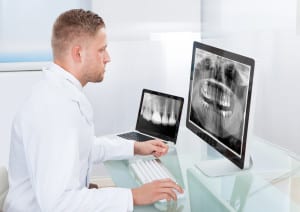 There are different types of x-rays including medical x-rays, dental x-rays, and even x-rays taken at the airport, and not all types of x-rays emit the same amount of radiation. The radiation from traditional dental x-rays is minute. However, digital x-rays have several benefits compared to traditional x-rays. Today we compare traditional x-rays to digital x-rays.
There are different types of x-rays including medical x-rays, dental x-rays, and even x-rays taken at the airport, and not all types of x-rays emit the same amount of radiation. The radiation from traditional dental x-rays is minute. However, digital x-rays have several benefits compared to traditional x-rays. Today we compare traditional x-rays to digital x-rays.
Traditional X-Rays
Traditional dental x-rays use film which is processed using liquid chemicals that are not good for the environment. Traditional x-rays also take up a lot of space when stored. Digital x-rays, on the other hand, can be stored right on a computer. By switching over to digital x-rays, dentists can help the environment, decrease radiation exposure for their patients, reduce storage space, and have a more accurate record of their patients’ dental needs.
Less Radiation
The one factor that patients are most interested in is radiation exposure. Dental x-rays are recommended yearly beginning at a very young age. Although radiation from dental x-rays is very minimal, parents no longer need to fret about their children being exposed to unknown levels. Digital x-rays produce 80 percent less radiation than traditional x-rays.
Quality
Digital x-rays are better quality because they are sharper and more detailed. They are viewed right on the computer and can be resized into larger images without distorting the picture or losing important details. The patient can view the images right along with their dentist so they can see the problem for themselves and understand why they need the procedure.
Comfort
Capturing digital x-rays is less intrusive than traditional x-rays. Traditional x-rays require biting down on stiff paper and holding them at awkward angles between your teeth. This can cause gagging and other discomfort. Digital x-rays are captured using a sensor that is connected by a wire to the computer. The sensor is easily moved and provides little to no discomfort.







